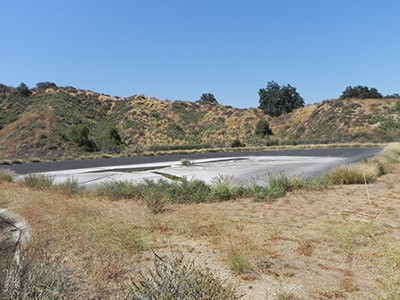Energy & Utility Services, Water Treatment Plant

Energy & Utility Services Organizational Chart
Energy & Utility Services
The Energy & Utility Services unit strives to procure the best value for energy and water supplies for the campus. Other responsibilities include identifying energy-efficiency projects and rebate programs that will help augment the repair and replacement of worn systems, as well as minimize utility expenses.
Through energy savings, Facilities Planning & Management built its chilled water central plant with a thermal energy storage unit. The plant provides chilled water to cool 18 major buildings in the core of the campus. The central plant reliably and efficiently produces chilled water, reduces noise pollution in each connected building, and lowers electrical consumption by 18% by operating during off-peak hours.
Additionally, heating, ventilation, air-conditioning and lighting systems in several major buildings and outside areas were retrofitted to provide increased comfort and improved lighting while also reducing energy consumption.
Through Executive Order No. 987, effective Aug. 2, 2006, the Chancellor of the California State University (CSU) system delegated the authority to each CSU campus president for implementing the CSU energy conservation policy. This supersedes, but contains similar goals, to CSU Executive Order 917.
Executive Order No. 987 required each CSU to reduce energy consumption at each CSU by 15% by the end of Fiscal Year 2009/2010 as compared to Fiscal Year 2003/2004. This was accomplished by an integrated design approach that included sustainable materials and practices in new and existing CSU facilities.
Cal Poly Pomona, through its Clean Energy Optimization Program (CEOP), begins a new phase in energy conservation through improved lighting products. Cal Poly Pomona partners with P2S Engineering to reduce demand for electricity and total electricity use by installing new lighting products.
The new lighting products benefit the campus in several ways; not only do they save energy, the new lamps (“light bulbs”) produce a more natural color of light that improves people’s ability to see.
Energy-efficient lamps save energy in two ways: the lamps use less energy and produce less waste heat, thus lowering the energy required for cooling a building.
Under consideration are:
- Interior lighting retrofit – LED light fixtures.
- Exterior lighting retrofit – Streets and walkway lights retrofitted with LED light fixtures.
- Improved timers and photocells to turn outdoor lights on and off at appropriate times.
- Occupancy sensors and timers inside buildings to turn lights on when needed and off when the building is empty.
- HVAC commissioning and controls upgrade – systems programmed with building analytics and energy information systems for continuous monitoring to ensure peak performance.
- Install high-efficient pumps, motors and variable speed drives to lower energy consumption
- Boiler replacement – old and inefficient heating boilers are replaced with high-efficient boilers.
Executive Order No. 987
Executive Order No. 1000
Electricity rates have been lowered due in part to securing favorable natural gas contracts for the campus. Steam and chilled water rates remain unchanged. However, water and sewer rate increases are a result of increases from the City of Pomona, which are passed to the campus customers.
UTILITY RATES SUMMARY - FY18/19 TO FY20/21
| Commodity | Fy 18/19 | Fy 19/20 | Fy 20/21 |
| Electricity | $1.28/kwh | $0.135/kwh | $0.154/kwh |
| Gas | $0.716/therm | $0.728/therm | $0.873/therm |
| Chilled Water | $0.152/ton-hr | $0.157/ton-hr | $0.157/ton-hr |
| Potable Water | $2.825/CCF | $2.910/CCF | $2.910/CCF |
| Recycled Water | $1.797/CCF | $1.634/CCF | $1.640/CCF |
| Sewer | $1.844/CCF | $1.899/CCF | $1.982/CCF |
The methodology used to calculate utilities rates is briefly defined as the total cost of producing and distributing utilities services divided by the number of units delivered.
If you have additional questions regarding utilities rates, including billing issues, please contact Utility Services at (909) 869-3034.
CPP manages energy, utilities and engineering projects for Cal Poly Pomona. These projects include:
- 2021: P2S HVAC Systems Upgrade
- 2021: Solar Energy Initiative
- 2021: Lower Reservoir Replacement
- 2021: Gym CHW Interior Building 43
- 2020: Road and Walkway Repairs
- 2020: Clean Energy Optimization Projects (CEOP)
- 2020: Well No. 1 Switchboard Upgrade
Water Treatment Plant

Joe Phillipy
- phone number or extension(909) 869-5189
- email addressjdphillipy@cpp.edu
About
Cal Poly Pomona’s $3.3-million reverse-osmosis water treatment plant, which opened in 2015, can produce 20,000 gallons of drinking water per hour and allows the university to obtain all its water needs from well water. Metropolitan Water District of Southern California water is used only as a backup. The university draws from the same aquifer as the cities of Pomona and Walnut.
With agriculture, livestock, landscaping and the population of a small municipality, water is the lifeblood of Cal Poly Pomona.
Under the feet of the campus community is nearly 30 miles of pipes that supply water to buildings, landscaping, crops, the plumbing system and even the air-conditioning hub. Colored sections of pipes outfitted with meters and sensors that spring up across campus help plumbers monitor and maintain the system.
Unlike the water supplied to many homes, the local water district is not the sole source of water for the university. Instead, Cal Poly Pomona produces and manages its own water supply and is one of a handful of CSU campuses that holds a permit as a public water system. Cal Poly Pomona is the only university with its own reverse-osmosis water treatment plant, which filters the campus supply of drinking water.
The permit allows the campus to operate like any other water purveyor. Cal Poly Pomona’s Department of Water Operations manages the treatment, production, regulatory compliance and water quality sampling for drinkable water used throughout campus. Water Operations falls under the umbrella of services performed by the Department of Facilities Planning & Management.
The simple act of turning on a faucet or filling a bottle at a water station belies the complexity of the university’s water infrastructure, which includes reservoirs, cooling towers, and four wells that date to the time of W.K. Kellogg.
Powerful pumps and huge pipes funnel groundwater from a campus-owned well to the university’s $3.3-million water treatment plant, which was funded by a grant from the Los Angeles County Department of Public Health grant and opened in fall 2015.
Well water is systematically treated into potable water that meets the State Drinking Water Standards. The Metropolitan Water District of Southern California, which conveys water from the Colorado River and the State Water Project in Northern California, is a backup resource for the campus.
The water is processed through a series of membrane filters that remove microscopic contaminants and is then disinfected with chlorine before it reaches faucets on campus. The reverse-osmosis water treatment plant can produce 20,000 gallons of drinking water per hour, which amounts to more than 60 million gallons of drinking water annually.
On a typical school day, 489,000 gallons of potable water are used by the campus community.
Two huge tanks, which are tucked away in elevated parts of campus, each store more than 500,000 gallons of potable water produced by the reverse-osmosis plant.
One of the tanks sits at the end of a winding road above Kellogg House. The other tank was built inside a former reservoir on a hill behind Building 1.
The annual Water Quality Report found that campus drinking water met or exceeded all health standards of the U.S. Environmental Protection Agency and the California Department of Public Health.
The potable water supply also plays a key role in cooling campus buildings during the blistering summer months.
The central cooling plant, which was completed in 1999, sits on a hill adjacent to a towering 2.6-million-gallon tank that stores water chilled to 38 degrees Fahrenheit inside the plant. That near-frozen water is used to cool the ambient air in buildings, which amounts to nearly 1.9 million square feet of space.
The central plant cooling towers evaporate 50,000 gallons of potable water a day as part of the process to produce chilled water for air conditioning in buildings. Hydronic pumps send the chilled water to the buildings, where smaller pumps propel the water to fans that cool rooms for faculty, staff and students. The water absorbs heat from the building spaces before returning to the central cooling plant where the water chilling cycle starts again.
The centralized cooling system eliminates the need for each building to have individual air-conditioning units. A state-of-the-art computer program monitors the temperature in all buildings. The system is so advanced that the temperature of most spaces can be changed using an app on a smart phone.
Another major component of the campus water system is a 2-million-gallon reservoir of reclaimed water that is used to irrigate crops and landscaping. A vast majority of the water used on campus comes from reclaimed sources.
The reservoir is surrounded by a chain-link fence and sits on a plateau overlooking Parking Lot M and the College of Environmental Design. Pumps are constantly running to keep the reservoir filled at all times, and plans are in place to replace the cover and liner on the reservoir to safeguard the water quality and reduce evaporation and leaks.
The reclaimed water is conveyed to the reservoir by pumps and a long series of underground pipes from a well and blended with purchased reclaimed water from the City of Pomona.
The university has four wells, one for drinking water and three set aside for irrigation, that are situated within a 1.5-mile radius from the center of campus. Two of the wells are located on Spadra Farm. Using well water for irrigation dates to the time of W.K. Kellogg.
During the height of a historic drought in 2015, Gov. Jerry Brown ordered mandatory statewide water-use reductions.
Cal Poly Pomona aimed for a 25% reduction in water use. Some of the measures taken at the time included the installation of low-flow restroom fixtures and urinals that use as little as a pint of water per flush. Improving the efficiencies of agricultural operations also was instituted.
Water is a valuable commodity. One of the goals of Facilities Planning & Management is to conserve water through oversight. Plans are in the works to convert the cooling towers to use reclaimed water and conserve drinking water. That change could conserve 1.1 million gallons of drinkable water each year.
Cal Poly Pomona’s Water Treatment Plant received an award from an industry group for its outstanding operations and maintenance.
The Southwest Membrane Operator Association (SWMOA) recognized the treatment plant with its 2020 Outstanding Membrane Plant Award – Small Facility. The industry group lauded the facility’s “outstanding plant operations and maintenance and exemplary membrane treatment plant performance.”
Cal Poly Pomona is the only college in the 23-campus California State University system to have its own water treatment facility. Because the plant serves the campus community, the university is considered a public water agency.
The plant can treat 20,000 gallons of drinking water per hour, which amounts to more than 60 million gallons of drinking water annually. On a typical academic day, 489,000 gallons of potable water are consumed by the campus community.
The water is processed through a series of membrane filters that remove microscopic contaminants and is then disinfected with chlorine before it reaches faucets, drinking fountains and filling stations. The water treatment plant is part of FP&M operations.
Powerful pumps and large pipes convey groundwater from a campus-owned well to the university’s water treatment plant, which was proportionally funded by Proposition 84 (The Safe Drinking Water, Water Quality and Supply. Flood Control, River and Coastal Protection Bond Act of 2006). The plant opened in fall 2015 and has been continuously providing the campus community with superior drinking water.
Water filtered through the treatment plant meets or exceeds standards set by the federal government. The results of campus testing are contained in the annual Water Quality Report.
The mission of the SWMOA is to enhance the professional development of the water treatment operator and the municipal and industrial applications they support. The association helps provide training and exchange of technical information to prepare membrane operators for the industry, which include symposiums, technical workshops, operator certification and outreach to students interested in the field of water treatment and technology.